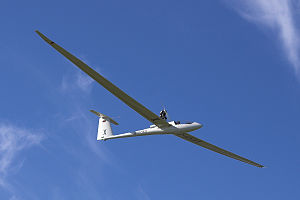Schempp-Hirth Nimbus-4
| Nimbus 4 | |
|---|---|
 |
|
| Nimbus 4M with powerplant deployed | |
| Role | high-performance FAI Open Class glider |
| Manufacturer | Schempp-Hirth Flugzeugbau GmbH |
| Designer | Klaus Holighaus |
| First flight | 1990 |
| Number built | 144 (as of 2011[update]) |
| Developed from | Schempp-Hirth Nimbus-3 |
The Schempp-Hirth Nimbus-4 is a family of high-performance FAI Open Class gliders designed by Klaus Holighaus and manufactured by Schempp-Hirth Flugzeugbau GmbH in Kirchheim, Germany. The Nimbus-4 first flew in 1990.
The Nimbus-4 family is a direct derivative of its predecessors at the highest performance end of the Schempp-Hirth product range, the Nimbus-2 and Nimbus-3. In total as of 2010[update], 44 single-seat and 100 two-seat models have been produced. The wing taper varies along the span, which is increased to 26.5 metres. The aspect ratio is 38.8. The fuselage is also lengthened and a larger rudder fitted.
The manufacturer claims this glider has a glide ratio of better than 60:1 at a best glide airspeed of 110 km/h (59 knots), meaning it can glide over 60 kilometres on course for every 1000 metres of altitude lost in still air.
There is a two-seat version, the 4D, and motor glider versions with either turbo engines (designation T) or self-launching engines (designation M).
The Nimbus-4DM is typical of the Nimbus-4 design, except for variations in cockpit and powerplant configuration and associated operating limitations. It is a 2-seat, high-performance motorized glider, constructed from fiber reinforced plastic (FRP) composites, featuring full span flight controls and a T-tail (with fixed horizontal stabilizer and two-piece elevator). The manufacturing process uses a hand lay-up of composite material plies and epoxy resins.
...
Wikipedia
